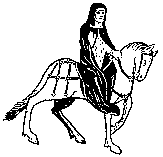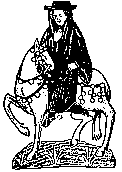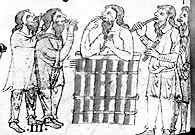Of the Prioress
At meat her manners were well taught withal;
No morsel from her lips did she let fall,
Nor dipped her fingers in the sauce too deep:
But she could carry a morsel up and keep
The smallest drop from falling on her breast.
For courtliness she had a special zest,
And she would wipe her upper lip so clean
That not a trace of grease was to be seen
Upon the cup when she had drunk; to eat,
she reached a hand sedately for the meat.
Of the Monk
He liked a fat swan best, and roasted whole.
Of the Franklin
His house was never short of bake-meat pies,
Of fish and flesh, and these in such supplies
it positively snowed with meat and drink
And all the dainties that a man could think.
According to the season of the year
Changes of dish were ordered to appear.
He kept fat partiridges in coops, beyond,
Many a bream and pike were in his pond.
Woe to the cook whose sauces had no sting
Or who was unprepared in anything!
Of the Doctor
In his own diet he observed some measure;
There were no superfluities for pleasure,
Only digestives, nutritives and such.
From Geoffrey Chaucer 1958 The Canterbury Tales Harmondsworth: Penguin (Translated into modern English by Nevill Coghill)




"I haven't a penny left," said Piers, "so I can't buy you pullets or geese or pigs. All I've got is a couple of fresh cheeses, a little curds and cream, an oat-cake, and two loaves of beans and bran which I baked for my children. Upon my soul, I haven't a scrap of bacon, and I haven't a cook to fry you steak and onions. But I've some parsley and shallots and plenty of cabbages, and a cow and calf, and a mare to cart my dung, till the drought is over."
From William Langland 1959 Piers the Ploughman Harmondsworth: Penguin (Translated into modern English by J.F. Goodridge)
You must not expect a variety of dishes from a Welsh kitchen, and there are no highly seasoned titbits to whet your appetite. In a Welsh house there are no tables, no tablecloths and no napkins. Everyone behaves quite naturally, with no attempt whatsoever at etiquette. You sit down in threes, not in pairs as elsewhwere, and they put the food in front of you, all together, on a single large trencher containing enough for three, resting on rushes and green grass. Sometimes they serve the main dish on bread, rolled out large and thin, and baked fresh each day."
From Gerald of Wales 1978 The Journey through Wales/ The Description of Wales Harmondsworth: Penguin (Translated by Lewis Thorpe)

Hail be ye bakers with your loves smale
Of white bred and blake, ful many anf fale!
Ye pincheth on the right weight ayens Goddes law:
to the fiare pillory ich rede ye take hede. ...............
Hail be ye hokesters down by the lake,
With candles and golokes and the pottes blake,
Tripes and kine feet and shepen hevedes! ........
From Celia and Kenneth Sisam (ed.) 1973 The Oxford Book of Medieval English Verse Oxford: Clarendon Press
If you are looking at this page without frames, there is more information about medieval writing to be found by going to the home page (framed) or the site map (no frames).